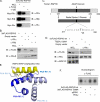Radial spoke protein 3 is a mammalian protein kinase A-anchoring protein that binds ERK1/2
- PMID: 19684019
- PMCID: PMC2785576
- DOI: 10.1074/jbc.M109.048181
Radial spoke protein 3 is a mammalian protein kinase A-anchoring protein that binds ERK1/2
Abstract
Initially identified in Chlamydomonas, RSP3 (radial spoke protein 3) is 1 of more than 20 identified radial spoke structural components of motile cilia and is required for axonemal sliding and flagellar motility. The mammalian orthologs for this and other radial spoke proteins, however, remain to be characterized. We found mammalian RSP3 to bind to the MAPK ERK2 through a yeast two-hybrid screen designed to identify interacting proteins that have a higher affinity for the phosphorylated, active form of the protein kinase. Consistent with the screening result, the human homolog, RSPH3, interacts with and is a substrate for ERK1/2. Moreover, RSPH3 is a protein kinase A-anchoring protein (AKAP) that scaffolds the cAMP-dependent protein kinase holoenzyme. The binding of RSPH3 to the regulatory subunits of cAMP-dependent protein kinase, RIIalpha and RIIbeta, is regulated by ERK1/2 activity and phosphorylation. Here we describe an ERK1/2-interacting AKAP and suggest a mechanism by which cAMP-dependent protein kinase-AKAP binding can be modulated by the activity of other enzymes.
Figures






Similar articles
-
Cell-permeable peptide-based disruption of endogenous PKA-AKAP complexes: a tool for studying the molecular roles of AKAP-mediated PKA subcellular anchoring.Am J Physiol Cell Physiol. 2009 Feb;296(2):C306-16. doi: 10.1152/ajpcell.00216.2008. Epub 2008 Dec 10. Am J Physiol Cell Physiol. 2009. PMID: 19073898
-
A-Kinase Anchoring Protein 4 (AKAP4) is an ERK1/2 substrate and a switch molecule between cAMP/PKA and PKC/ERK1/2 in human spermatozoa.Sci Rep. 2016 Nov 30;6:37922. doi: 10.1038/srep37922. Sci Rep. 2016. PMID: 27901058 Free PMC article.
-
Protein kinase A RII-like (R2D2) proteins exhibit differential localization and AKAP interaction.Cell Motil Cytoskeleton. 2008 Jul;65(7):539-52. doi: 10.1002/cm.20279. Cell Motil Cytoskeleton. 2008. PMID: 18421703
-
Neurochondrin is an atypical RIIα-specific A-kinase anchoring protein.Biochim Biophys Acta. 2015 Oct;1854(10 Pt B):1667-75. doi: 10.1016/j.bbapap.2015.04.018. Epub 2015 Apr 23. Biochim Biophys Acta. 2015. PMID: 25916936 Free PMC article.
-
The flagellar motility of Chlamydomonas pf25 mutant lacking an AKAP-binding protein is overtly sensitive to medium conditions.Mol Biol Cell. 2006 Jan;17(1):227-38. doi: 10.1091/mbc.e05-07-0630. Epub 2005 Nov 2. Mol Biol Cell. 2006. PMID: 16267272 Free PMC article.
Cited by
-
General and specific promotion of flagellar assembly by a flagellar nucleoside diphosphate kinase.Mol Biol Cell. 2017 Nov 1;28(22):3029-3042. doi: 10.1091/mbc.E17-03-0156. Epub 2017 Sep 6. Mol Biol Cell. 2017. PMID: 28877983 Free PMC article.
-
Complex modular architecture around a simple toolkit of wing pattern genes.Nat Ecol Evol. 2017;1(3):52. doi: 10.1038/s41559-016-0052. Epub 2017 Jan 30. Nat Ecol Evol. 2017. PMID: 28523290 Free PMC article.
-
The mouse radial spoke protein 3 is a nucleocytoplasmic shuttling protein that promotes neurogenesis.Histochem Cell Biol. 2015 Oct;144(4):309-19. doi: 10.1007/s00418-015-1338-y. Epub 2015 Jun 17. Histochem Cell Biol. 2015. PMID: 26082196
-
Genome-wide interaction study of smoking and bladder cancer risk.Carcinogenesis. 2014 Aug;35(8):1737-44. doi: 10.1093/carcin/bgu064. Epub 2014 Mar 24. Carcinogenesis. 2014. PMID: 24662972 Free PMC article.
-
Heterogeneity of radial spoke components in Tetrahymena cilia.Cell Mol Life Sci. 2025 Aug 31;82(1):329. doi: 10.1007/s00018-025-05871-x. Cell Mol Life Sci. 2025. PMID: 40886204 Free PMC article.
References
-
- Raman M., Chen W., Cobb M. H. (2007) Oncogene 26, 3100–3112 - PubMed
-
- Elion E. A. (2001) J. Cell Sci. 114, 3967–3978 - PubMed
-
- Kolch W. (2005) Nat. Rev. Mol. Cell Biol. 6, 827–837 - PubMed
-
- Morrison D. K., Davis R. J. (2003) Annu. Rev. Cell Dev. Biol. 19, 91–118 - PubMed
-
- Rubin C. S. (1994) Biochim. Biophys. Acta 1224, 467–479 - PubMed
Publication types
MeSH terms
Substances
Grants and funding
LinkOut - more resources
Full Text Sources
Molecular Biology Databases
Miscellaneous

